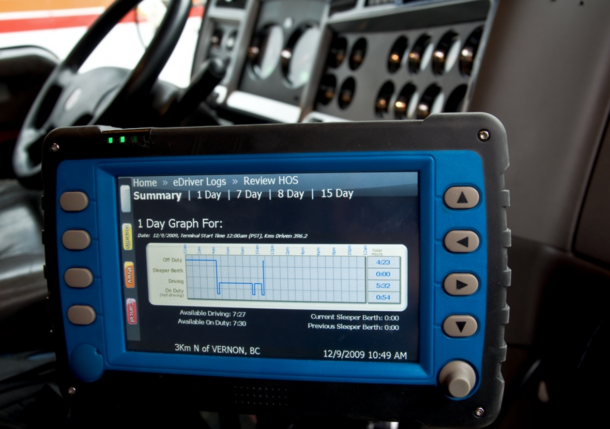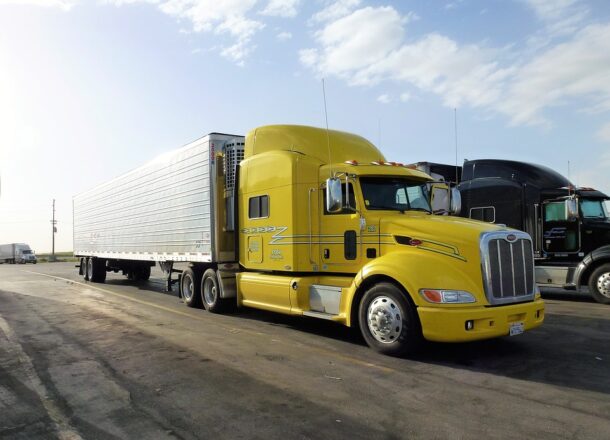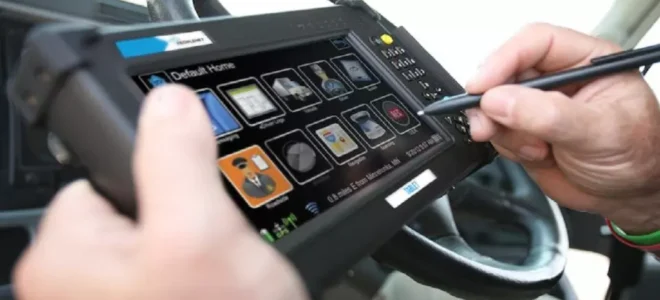Are you familiar with the ELD (Electronic Logging Device) mandate? If you’re in the trucking industry, understanding this regulation is crucial. In this article, we will provide you with everything you need to know about ELD devices for trucks.
The ELD mandate was put in place by the Federal Motor Carrier Safety Administration (FMCSA) to improve safety and compliance in the trucking industry. ELDs are electronic devices that monitor and record a driver’s hours of service (HOS) electronically. They replace the traditional paper logbooks, making the process more efficient and accurate.
In this informative guide, we will cover the basics of ELDs, including their functionality, benefits, and compliance requirements. You will learn how ELD devices work, their features, and how to choose the right one for your fleet. Furthermore, we will discuss the impact of ELDs on driver safety, compliance with HOS regulations, and fleet management.
Why are ELD devices important for trucking companies?

Source: fulltiltlogistics.com
ELD devices play a crucial role in the trucking industry by ensuring that drivers and fleets comply with the hours of service (HOS) regulations. These regulations are designed to prevent driver fatigue and promote safer roads. ELD devices automate the HOS recording process, eliminating the need for manual logbooks and reducing the risk of errors.
One of the key benefits of ELD devices is their ability to accurately track and record a driver’s hours of service. This not only helps to ensure compliance with HOS regulations but also promotes driver safety. By monitoring a driver’s hours of service, ELD devices can prevent instances of fatigue driving, which is a major cause of accidents on the road.
Additionally, ELD devices provide valuable data that can be used for fleet management purposes. Fleet managers can access real-time information about a driver’s hours of service, allowing them to better plan routes, schedules, and assignments. This data can also be used to identify patterns and trends, enabling fleets to optimize their operations and improve efficiency.
In summary, ELD devices are important for trucking companies because they promote compliance with HOS regulations, enhance driver safety, and provide valuable data for fleet management.
How do ELD devices work?

Source: fulltiltlogistics.com
ELD devices utilize advanced technology to accurately monitor and record a driver’s hours of service. These devices are typically connected to the vehicle’s engine and capture data such as engine hours, miles driven, and vehicle movement. They also incorporate GPS technology to track the vehicle’s location and record accurate timestamps.
The data collected by ELD devices is then transmitted to a secure server or cloud-based platform, where it can be accessed by the driver, fleet managers, and regulatory authorities. This ensures that the recorded information is tamper-proof and readily available for inspections and audits.
ELD devices are designed to be user-friendly and intuitive. They often feature a user interface that allows drivers to easily log in and view their hours of service. Some devices also offer additional features such as driver messaging, vehicle diagnostics, and real-time traffic updates.
Overall, ELD devices work by seamlessly integrating with the vehicle’s engine and using advanced technology to accurately track and record a driver’s hours of service.
Benefits of using ELD devices

Source: geotab.com
Using ELD devices offers numerous benefits for trucking companies and drivers. Let’s explore some of the key advantages:
- Improved Compliance: ELD devices ensure accurate and reliable recording of a driver’s hours of service, reducing the risk of non-compliance with HOS regulations. This helps to avoid costly fines and penalties.
- Enhanced Driver Safety: By monitoring a driver’s hours of service, ELD devices help prevent instances of fatigue driving, improving overall driver safety and reducing the risk of accidents.
- Time and Cost Savings: ELD devices automate the HOS recording process, eliminating the need for manual logbooks. This saves drivers and fleet managers valuable time and reduces administrative costs.
- Accurate Data Reporting: ELD devices provide real-time and accurate data on a driver’s hours of service, which can be used for reporting and analysis. This data can help identify inefficiencies, optimize routes, and improve overall fleet performance.
- Streamlined Inspections: With ELD devices, the hours of service data is readily available for inspections, making the process faster and more efficient. This reduces the time spent on roadside inspections and minimizes disruptions to operations.
In conclusion, using ELD devices offers significant benefits for trucking companies, including improved compliance, enhanced driver safety, time and cost savings, accurate data reporting, and streamlined inspections.
ELD device regulations and compliance

Source: simplexgroup.net
The FMCSA has established specific regulations and compliance requirements for ELD devices. It is important for trucking companies to understand and adhere to these regulations to avoid penalties and ensure compliance.
Here are some key aspects of ELD device regulations:
- Mandate Requirements: The ELD mandate requires commercial motor vehicle drivers to use ELD devices that meet the FMCSA’s technical specifications. These devices must be registered and certified by the FMCSA.
- Recordkeeping: ELD devices must record and retain specific data, including date, time, location, engine hours, vehicle miles, and driver identification information. This data should be easily accessible for inspection purposes.
- Data Transfer: ELD devices must have the capability to transfer data to authorized individuals, such as law enforcement officers and safety officials, during inspections or audits. This can be done via wireless communication or a USB connection.
- Driver Privacy: ELD devices should protect driver privacy by only sharing necessary information during inspections. Drivers also have the right to review and certify their own records.
- Exemptions: Some drivers may be exempt from using ELD devices, such as those who operate under the short-haul exemption or who use paper logs for no more than 8 days in a 30-day period.
It is essential for trucking companies to carefully review and select ELD devices that comply with the FMCSA regulations. By doing so, they can ensure smooth operations and avoid penalties.
Choosing the right ELD device for your fleet

Source: freightwaves.com
Choosing the right ELD device for your fleet is a crucial decision that requires careful consideration. With numerous options available in the market, it’s important to evaluate your fleet’s specific needs and requirements.
Here are some factors to consider when selecting an ELD device:
- FMCSA Compliance: Ensure that the ELD device you choose is registered and certified by the FMCSA, meeting all the technical specifications and requirements outlined in the mandate.
- User-Friendly Interface: Look for an ELD device that has an intuitive and user-friendly interface. This will make it easier for drivers to log in, view their hours of service, and navigate through the device’s features.
- Reliability and Durability: Consider the device’s reliability and durability, as it will be subjected to harsh conditions in the trucking industry. Look for devices that are built to withstand vibration, temperature variations, and other environmental factors.
- Integration with Fleet Management Software: If you already use fleet management software, ensure that the ELD device can integrate seamlessly with your existing system. This will allow you to streamline your operations and access comprehensive data in one place.
- Customer Support and Training: Evaluate the customer support and training provided by the ELD device manufacturer. Look for companies that offer comprehensive training programs and responsive support to help your drivers and fleet managers navigate any issues or questions that may arise.
By carefully considering these factors and conducting thorough research, you can choose an ELD device that meets the unique needs of your fleet and ensures compliance with FMCSA regulations.
Installing and setting up an ELD device

Source: forbes.com
Once you have selected an ELD device for your fleet, it’s important to ensure proper installation and setup.
Follow these steps to install and set up your ELD device:
- Read the Instructions: Carefully read the installation and setup instructions provided by the ELD device manufacturer. Familiarize yourself with the device’s components and features.
- Choose a Suitable Location: Select a suitable location in the vehicle to install the ELD device. This should be a secure and easily accessible spot that is not obstructed by other components.
- Connect the Device: Connect the ELD device to the vehicle’s engine control module (ECM) using the provided cables and connectors. Ensure that the connections are secure and properly tightened.
- Power On the Device: Once the device is connected, power it on and follow the on-screen prompts to set up the device. This may involve entering vehicle information, driver credentials, and other necessary details.
- Test the Device: After the initial setup, conduct a test to ensure that the ELD device is functioning properly. Check if it is accurately recording engine hours, vehicle movement, and other relevant data.
- Train Drivers: Provide comprehensive training to your drivers on how to use the ELD device. Familiarize them with the user interface, logging in and out, and accessing their hours of service information.
- Monitor and Maintain: Regularly monitor the ELD devices in your fleet to ensure proper functioning. Conduct routine checks and maintenance to address any issues or concerns that may arise.
By following these steps, you can successfully install and set up an ELD device in your fleet, ensuring accurate recording of hours of service and compliance with FMCSA regulations.
Training drivers on using ELD devices

Source: kinneypike.com
Proper training is essential to ensure that drivers can effectively and efficiently use ELD devices. Here are some tips for training drivers on using ELD devices:
- Provide Detailed Instructions: Clearly explain how to log in and out of the device, view hours of service information, and navigate through the device’s features. Provide step-by-step instructions and visual aids, if necessary.
- Demonstrate Real-Life Scenarios: Use real-life scenarios to demonstrate how drivers should use the ELD device in different situations. This can help drivers understand how to accurately record their hours of service and handle exceptions, such as yard moves or personal conveyance.
- Address Frequently Asked Questions: Anticipate common questions and concerns that drivers may have about using ELD devices. Provide answers and explanations to address these concerns during the training session.
- Encourage Hands-On Practice: Allow drivers to practice using the ELD device during the training session. Provide guidance and support as they navigate through the device’s features and functions.
- Offer Ongoing Support: After the initial training, offer ongoing support to drivers. Encourage them to reach out if they have any questions or issues with the ELD device. Provide additional training sessions or resources as needed.
By providing comprehensive training and ongoing support, you can ensure that your drivers are well-equipped to use ELD devices effectively and comply with FMCSA regulations.
Common challenges and solutions when using ELD devices

Source: fccr.co
While ELD devices offer numerous benefits, they can also present some challenges. Here are some common challenges that trucking companies may face when using ELD devices, along with potential solutions:
- Driver Resistance: Some drivers may initially resist the transition from paper logbooks to ELD devices. To address this, provide comprehensive training and emphasize the benefits of using ELD devices, such as improved compliance and driver safety.
- Technical Issues: ELD devices may occasionally experience technical issues, such as connectivity problems or software glitches. To mitigate these issues, ensure that you partner with a reputable ELD device manufacturer that offers responsive customer support and regular software updates.
- Data Security: Data security is a concern for many trucking companies. To protect sensitive data, choose ELD devices that offer robust security features, such as encryption and user authentication. Regularly update the device’s software to address any potential vulnerabilities.
- Driver Errors: Drivers may occasionally make errors when using ELD devices, such as forgetting to log in or incorrectly recording their hours of service. To minimize these errors, provide ongoing training, conduct periodic audits, and encourage open communication with drivers.
- Changing Regulations: Regulations regarding ELD devices may evolve over time. Stay informed about any updates or changes to the regulations and ensure that your ELD devices remain compliant. Regularly communicate with drivers and provide them with any necessary updates or training.
By addressing these challenges proactively and implementing appropriate solutions, you can maximize the benefits of using ELD devices and ensure smooth operations within your fleet.
Conclusion
ELD devices have revolutionized the trucking industry by streamlining the hours of service recording process and promoting compliance with regulations. These devices offer numerous benefits, including improved driver safety, time and cost savings, and accurate data reporting.
As technology continues to advance, we can expect further enhancements in ELD devices. Features such as predictive analytics, real-time driver coaching, and integration with other fleet management systems are likely to become more prevalent.
In conclusion, ELD devices are here to stay and will continue to shape the future of the trucking industry. By embracing this technology and ensuring compliance with regulations, trucking companies can enhance safety, improve efficiency, and drive success in their operations.




